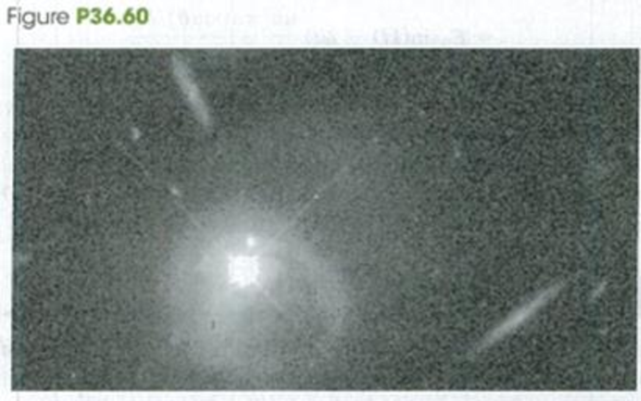
Concept explainers
Quasars, an abbreviation for quasi-stellar radio sources, are distant objects that look like stars through a telescope but that emit far more

Trending nowThis is a popular solution!

Chapter 36 Solutions
UNIV. PHYS. V.2 W/MOD. MAST. >LLF< >IC
Additional Science Textbook Solutions
Physics for Scientists and Engineers with Modern Physics
Sears And Zemansky's University Physics With Modern Physics
The Cosmic Perspective
University Physics (14th Edition)
Glencoe Physical Science 2012 Student Edition (Glencoe Science) (McGraw-Hill Education)
- The elliptical galaxy NGC 4889 is the largest galaxy in the Coma Cluster (shown in the image below taken by the Hubble Space Telescope). After analysing the spectrum of NGC 4889, an astronomer identifies a spectral line as being CaII (singly ionised Calcium) with a measured wavelength of 401.8 nm. The true, rest wavelength of this spectral line, measured in a lab, is 393.3 nm. What would be this galaxy’s recessional velocity, in km/s?arrow_forwardYou want a telescope that discerns objects that are at least 5.10 * 10-7 radians apart. To achieve this resolution, determine what the diameter of the primary mirror must be if you are making observations at a wavelength of 583 nm. A binary star system is 41.3 ly away. the two stars would just barely be able to be discerned by your telescope. determine the minimum distance between the stars. ly = 9.461 *1015arrow_forwardIf we consider a weak gravitational field, we can write a simple expression for gravitational time dilation. Looking from a region distant from the gravitating body, light will appear to travel more slowly due to this time dilation. We can model this as a refractive index, with n > 1. What refractive index distribution in a spherical lens mimics gravitational deflection by an object? If we replace the lens by a thin plate of varying thickness, what is the required thickness?arrow_forward
- Q. In a Newton’s ring experiment the diameters of 4th and 12th dark rings are .400 and .700 cm respectively. Deduce the diameter of 20th dark ring.arrow_forwardThe bright star Mintaka (also known as δ Orionis,the western most star of Orion’s belt) is extremely close to the celestial equator. Amateur astronomers can determine the field of view of their telescope (that is the angular width of the region that they can see through the telescope) by timing how long it takes Mintaka to drift through the field of view when the telescope is held stationary in hour angle. How long does it takeMintaka to drift through a 1 degree field of view?arrow_forwardQ1(A). Prove using step-by-step solution that f(v) = E/h is equal to 1.80x1015 Hz, therefore λ = C/f is equal to 254nm. Q1(B). Refer to the visible light spectrum to determine what region of EM radiation does this light fall? Q1(C). Show step-by step solution to integrate the velocity function if the initial position of the particle is s(0) = 9. Find the particle position at: (1) t = 1 sec ; (2) t = 5 secarrow_forward
- Q#03. Show that the (hkl) plane is perpendicular to the [hkl] direction.arrow_forwardQ. 1. Light with an energy flux of 20 W/cm² falls on a non-reflecting surface at normal incidence. If the surface has an area of 30 cm², the total momentum delivered (for complete absorption) during 30 minutes is: (a) 36 x 10-5 kg m/s. (c) 108 x 104 kg m/s. (b) 36 x 104 kg m/s. (d) 1.08 × 107 kg m/s.arrow_forwardYou're inside a metal building that blocks radio waves, but you're trying to make a call with your cell phone, which broadcasts at a frequency of 950 MHz. Down the hall from you is a narrow win- dow measuring 35 cm wide. What's the horizontal angular width of the beam (i.e., the angle between the first minima) from your phone as it emerges from the window?arrow_forward
- JUST NEED HELP WITH D-J! A large container holds two layers of liquid: a 10.0 cm thick layer of vegetable oil (ρ = 920 kg/m3 , n = 1.47) above a 20.0 cm thick layer of water (ρ = 1000 kg/m3 , n = 1.33). There is air (ρ = 1.20 kg/m3 , n = 1.0003) above the oil layer. Nia holds a red laser which emits 632.8 nm light to the right and down, so that the ray makes an angle of 50.0° relative to a line normal to the oil layer. a) Draw a diagram showing the layers of liquid and the path of a light ray. At each interface between media, there should be a reflected ray and a refracted ray unless there is total internal reflection at that interface (in which case write N/A for the angle of refraction). Label the angles of each ray (incident, reflected, and refracted) for each interface. b) What is the angle of reflection at the air→ oil interface? ________________________ c) What is the angle of refraction at the air→ oil interface? ________________________ d) What is the angle of incidence at the…arrow_forwardConsider a typical red laser pointer with wavelength 649 nm. What is the light's frequency in hertz? (Recall the speed of light c = 3.0 × 108 m/s.) f =arrow_forwardQ. 1. Light with an energy flux of 20 W/cm2 falls on a non-reflecting surface at normal incidence. If the surface has an area of 30 cm², the total momentum delivered (for complete absorption) during 30 minutes is: (a) 36 x 10-5 kg m/s. (c) 108 x 104 kg m/s. (b) 36 x 104 kg m/s. (d) 1.08 x 107 kg m/s.arrow_forward
 College PhysicsPhysicsISBN:9781305952300Author:Raymond A. Serway, Chris VuillePublisher:Cengage Learning
College PhysicsPhysicsISBN:9781305952300Author:Raymond A. Serway, Chris VuillePublisher:Cengage Learning University Physics (14th Edition)PhysicsISBN:9780133969290Author:Hugh D. Young, Roger A. FreedmanPublisher:PEARSON
University Physics (14th Edition)PhysicsISBN:9780133969290Author:Hugh D. Young, Roger A. FreedmanPublisher:PEARSON Introduction To Quantum MechanicsPhysicsISBN:9781107189638Author:Griffiths, David J., Schroeter, Darrell F.Publisher:Cambridge University Press
Introduction To Quantum MechanicsPhysicsISBN:9781107189638Author:Griffiths, David J., Schroeter, Darrell F.Publisher:Cambridge University Press Physics for Scientists and EngineersPhysicsISBN:9781337553278Author:Raymond A. Serway, John W. JewettPublisher:Cengage Learning
Physics for Scientists and EngineersPhysicsISBN:9781337553278Author:Raymond A. Serway, John W. JewettPublisher:Cengage Learning Lecture- Tutorials for Introductory AstronomyPhysicsISBN:9780321820464Author:Edward E. Prather, Tim P. Slater, Jeff P. Adams, Gina BrissendenPublisher:Addison-Wesley
Lecture- Tutorials for Introductory AstronomyPhysicsISBN:9780321820464Author:Edward E. Prather, Tim P. Slater, Jeff P. Adams, Gina BrissendenPublisher:Addison-Wesley College Physics: A Strategic Approach (4th Editio...PhysicsISBN:9780134609034Author:Randall D. Knight (Professor Emeritus), Brian Jones, Stuart FieldPublisher:PEARSON
College Physics: A Strategic Approach (4th Editio...PhysicsISBN:9780134609034Author:Randall D. Knight (Professor Emeritus), Brian Jones, Stuart FieldPublisher:PEARSON





